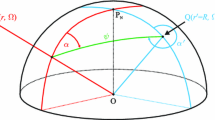Summary
A principle of determining the Earth's gravitational field through the Stokes' constants is presented. The problem is properly posed according to Hadamard. The zero-frequency tidal terms due to the Moon and the Sun are introduced analytically into the absolute terms of equations. The ellipsoidal coordinates are used. The reference field should be so close to the actual one, that the problem can be solved in a linear approximation. The proximity of the fields mentioned does not need to be of the highest possible degree.
Similar content being viewed by others
References
M. I. Yurkina, Z. Šimon, A. Zeman: Constant part of the Earth tides in the Earth figure theory. Bull. géodesique,60 (1986), 339–343.
L. N. Sretensky: The theory of the Newton's potential. Moscow — Leningrad (1946), 318 pp. (in Russian).
M. I. Yurkina: Molodensky's theory of the Earth's figure determination using topographic reductions and integration over the Earth's surface. Manuscripta geodaetica,14 (1989), 7–12.
M. I. Vishik, O. A. Ladyzhenskaya: Boundary value problems for partial differential equations and certain classes of operator equations. Uspekhi matematicheskikh nauk,11 (1956), 41–97 (in Russian).
P. G. Dirichlet: Ueber einen neuen Ausdruck zur Bestimmung der Dichtigkeit einer unendlich dünnen Kugelschale, wenn der Werth des Potentials derselben in jedem Punkte ihrer Oberfläche gegeben ist. Mathematische Abhandlungen der Königlichen Akademie der Wissenschaften zu Berlin. Aus dem Jahre 1850., Berlin (1852), 99–116. Dirichlet's Werke, 2 Bd. Berlin (1897), 67–88 (in German).
M. Burša: Single-layer density as function of Stokes' constants. Studia geoph. et geod.,15 (1971), 113–123.
L. P. Pellinen: Effects of the Earth ellipticity on solving geodetic boundary value problem. Boll. di geodesia e scienze affini,41 (1982), 89–103.
E. W. Hobson: The theory of spherical and ellipsoidal harmonics. Cambridge. At the University press., (1931). Reprint of the Chelsea Publishing Company., New York (1955), 500 pp.
N. C. Thong, E. W. Grafarend: A spheroidal harmonic model of the terrestrial gravitational field. Manuscripta geodaetica,14 (1989), 285–304.
C. Niven: On the conduction of heat in ellipsoids of revolution. Phil. Trans. Royal Soc. of London,171 (1980), Part I, 117–151.
J. P. Vinti: New approach in the theory of satellite orbits. Phys. Rev. Lett.,3 (1959), 8.
J. P. Vinti: Zonal harmonic perturbations of an accurate reference orbit of an artificial satellite. Journal of research of the National Bureau of Standards, B, Mathematics and mathematical physics,67 (1963), 191–222.
M. D. Kislik: The movement of an artificial satellite in the normal Earth gravitational field. In the issue Iskusstvennye sputniki Zemli,4 (1960), 3–17 (in Russian).
E. P. Axenov, E. A. Grebenikov, V. G. Demin: A general solution of the problem about the movement of an artificial satellites in the normal Earth attraction field. In the issue Iskusstvennye sputniki Zemli,8 (1961), 64–71 (in Russian).
D. Brouwer, G. M. Clemence: Methods of celestial mechanics. Academic press, New York and London, 1961.
I. G. Izsák: A theory of satellite motion about an oblate planet. I. A second order solution of Vinti's dynamical problem. Smithsonian contribution to astrophysics, Res. Space Sci.,6 (1963), 81–107.
M. S. Molodensky, V. F. Eremeev, M. I. Yurkina: Methods for study of the external gravitational field and figure of the Earth. (1960), Israel program for scientific translations. Jerusalem (1962) (translation from the Russian).
A. Zeman: Definition of the normal gravity field including the constant part of tides. Studia geoph. et geod.,31 (1987), 113–120.
P. Pizzetti: Principii della teoria meccanica della figura dei pianeti. Pisa (1913), The Russian edition (1933) Moscow — Leningrad, Gossudarstvennoye tekhniko-teoreticheskoye usdatel'stvo.
V. V. Brovar: On the potentials of origins of isolated levelling nets. Manuscripta geodaetica,13 (1988), 29–32.
P. Holota: The altimetry-gravimetry boundary value problem. Boll. di Geod. e Sci. Affini, Auno XLII,1 (1983), 13–32 and 69–84.
V. F. Eremeev, M. I. Yurkina: Integral equations for the single-layer density. In a book “Molodensky's integral equations for Earth's figure theory”. Trudy CNIIGAiK,198 (1972), 57–178 (in Russian).
L. P. Pellinen: Reference systems in solving Molodensky's problem for the sea surface. Proc. 4th Int. Symp. Geod. and Phys. of the Earth. Part II. Veröff. d. Zentralinst. f. Phys. d. Erde,63 (1981), Teil II, Potsdam, 424–429.
M. I. Yurkina: Potential at the origin of heights and the gauging of the geometrical levelling. Geodeziya i Kartografiya,10 (1981), 11–15 (in Russian).
Author information
Authors and Affiliations
Additional information
Contribution to the I.A.G. Special Commission SC3 Fundamental Constants (SCFC)
Rights and permissions
About this article
Cite this article
Yurkina, M.I. Determination of Stokes' constants respecting zero -frequency tidal term due to the Moon and the Sun. Stud Geophys Geod 37, 317–325 (1993). https://doi.org/10.1007/BF01613578
Received:
Revised:
Published:
Issue Date:
DOI: https://doi.org/10.1007/BF01613578




